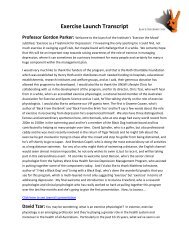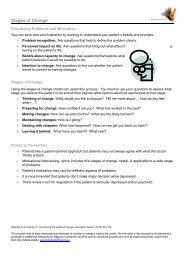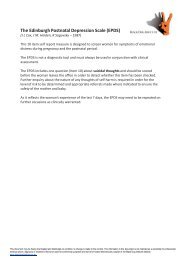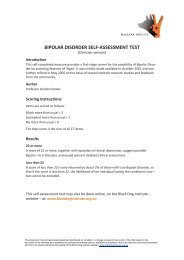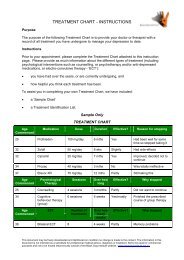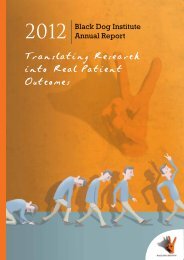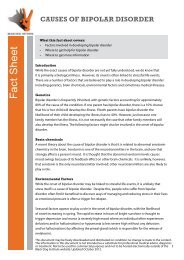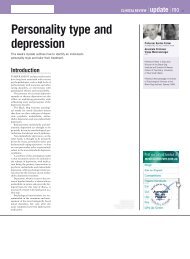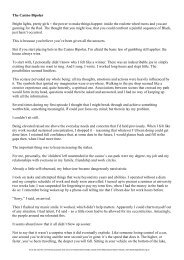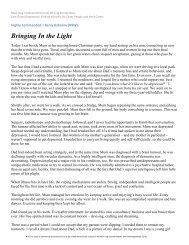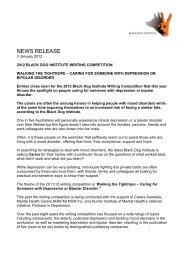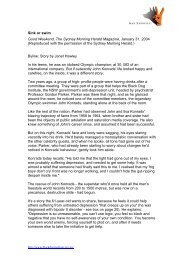Sub-types of depression - Black Dog Institute
Sub-types of depression - Black Dog Institute
Sub-types of depression - Black Dog Institute
You also want an ePaper? Increase the reach of your titles
YUMPU automatically turns print PDFs into web optimized ePapers that Google loves.
SUB-TYPES Of DEPRESSIONFact Sheet2. Melancholic <strong>depression</strong>Melancholic <strong>depression</strong> is also a biological <strong>depression</strong>. Its defining features are:• A more severe depressed mood than is the case with non-melancholic <strong>depression</strong>• Psychomotor disturbance such as slowed or agitated physical movements and slowedcognitive processing abilitiesMelancholic <strong>depression</strong> is a relatively uncommon type <strong>of</strong> <strong>depression</strong>. It affects only2-10 per cent <strong>of</strong> diagnosed cases in Western populations. The percentage <strong>of</strong> affected menand women is roughly the same.Melancholic <strong>depression</strong> has a low rate <strong>of</strong> spontaneous remission, meaning it very rarelygoes away <strong>of</strong> its own accord. It responds best to physical treatments (e.g. antidepressantdrugs) and only minimally (at best) to non-physical treatments such as counselling orpsychotherapy as a first step. However, psychological interventions can be helpful oncethe symptoms have subsided and during the recovery period.3. Non-melancholic <strong>depression</strong>Non-melancholic <strong>depression</strong>s have to do with psychological causes, personalitycharacteristics and are <strong>of</strong>ten linked to stressful events in a person’s life. Non-melancholic<strong>depression</strong> is the most common <strong>of</strong> the three <strong>types</strong> <strong>of</strong> <strong>depression</strong> but it can be hardto accurately diagnose because it lacks the defining characteristics <strong>of</strong> the other twodepressive <strong>types</strong> (namely psychomotor disturbance or psychotic features). In contrast tothe other <strong>types</strong> <strong>of</strong> <strong>depression</strong>, non-melancholic <strong>depression</strong> has a high rate <strong>of</strong> spontaneousremission which means that the <strong>depression</strong> resolves over time by itself. This is becausenon-melancholic <strong>depression</strong> is <strong>of</strong>ten linked to stressful life events which, when resolved,tend to result in the <strong>depression</strong> also lifting. Non-melancholic <strong>depression</strong> responds well toa range <strong>of</strong> treatment options including psychological interventions, antidepressants andcounselling.Key points to remember• There are three different sub-<strong>types</strong> <strong>of</strong> <strong>depression</strong>, each with their own features andcauses• Knowing what sub-type <strong>of</strong> <strong>depression</strong> a person has is important in being able to selectthe best treatment options• Psychotic and melancholic <strong>depression</strong> are a more biological sub-type <strong>of</strong> <strong>depression</strong>,resulting in more severely depressed mood and psychomotor disturbance• Non-melancholic <strong>depression</strong> is the most common form <strong>of</strong> <strong>depression</strong> and is <strong>of</strong>tenlinked to stressful life events, personality and coping styles.www.blackdoginstitute.org.auThis document may be freely downloaded and distributed on condition no change is made to the content.The information in this document is not intended as a substitute for pr<strong>of</strong>essional medical advice, diagnosisor treatment. Not to be used for commercial purposes and not to be hosted electronically outside <strong>of</strong> the<strong>Black</strong> <strong>Dog</strong> <strong>Institute</strong> website. Updated October 2012.2



